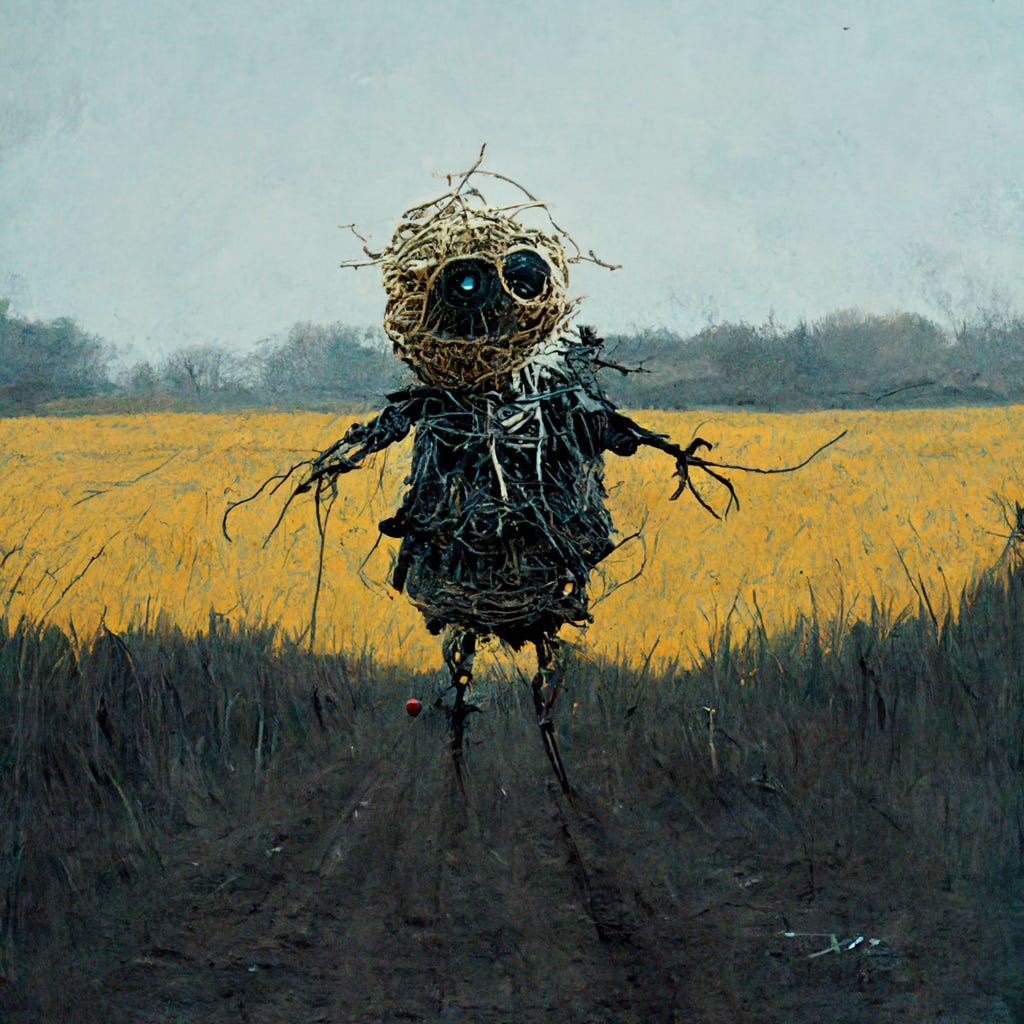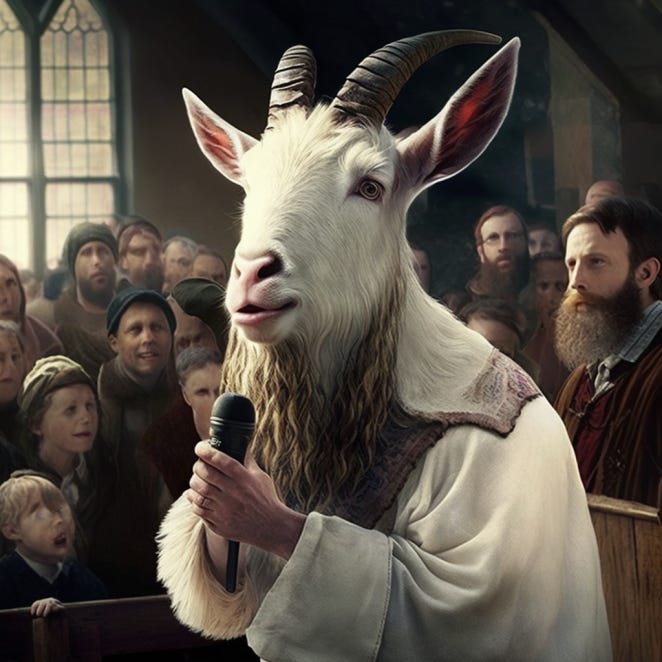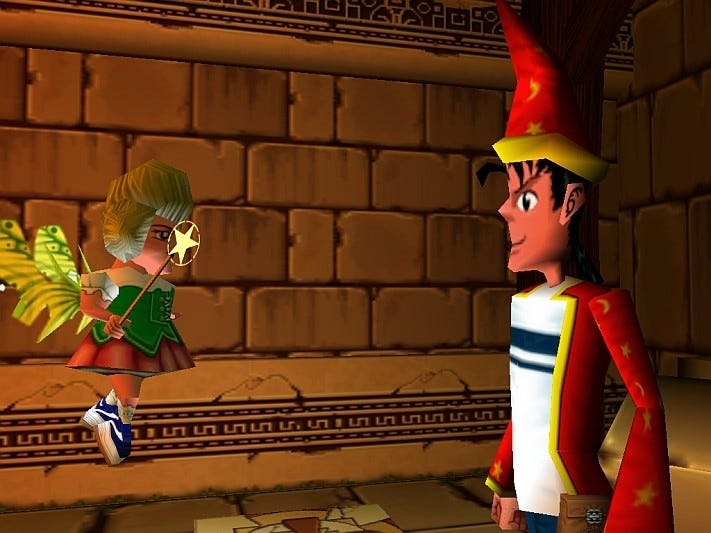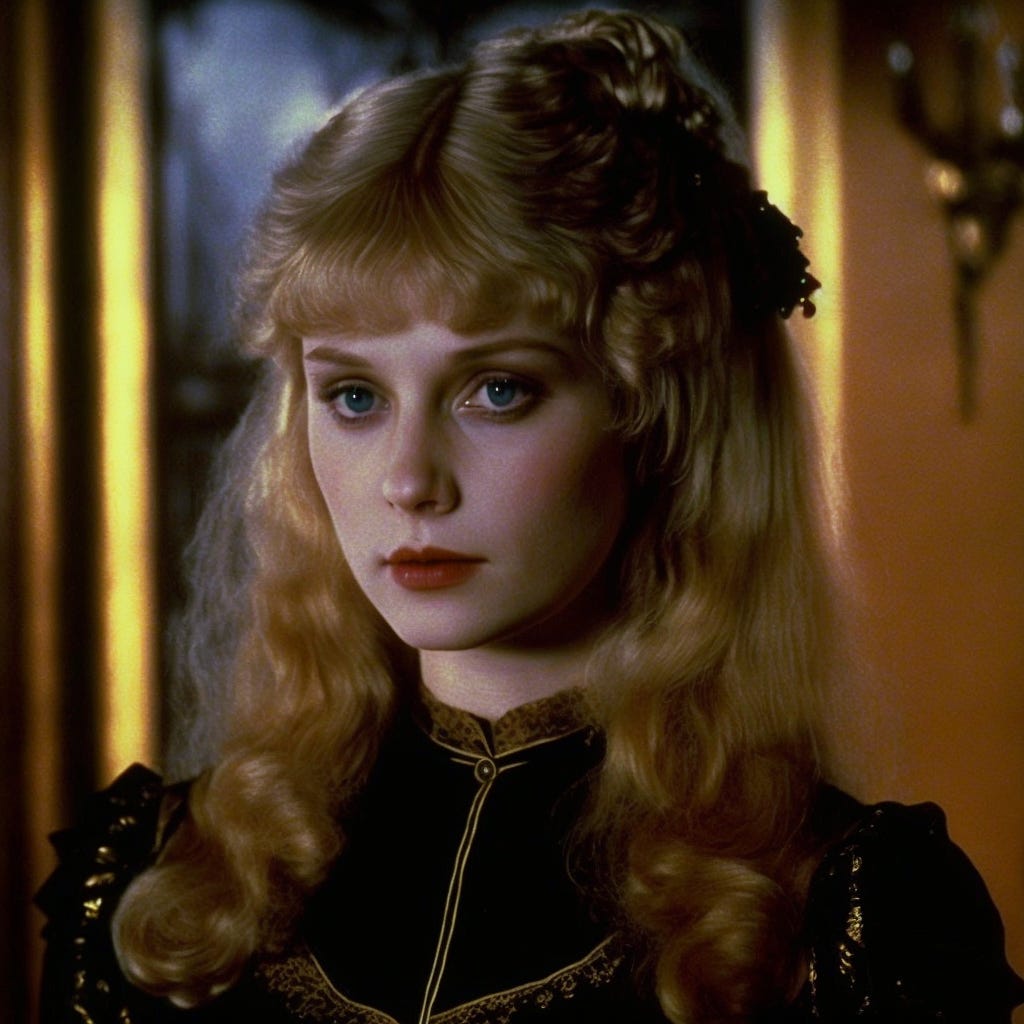AI's Faustian Bargain
We make deals with the devil every day

A couple of months ago I had a conversation with a taxi driver about AI. I told him that I’m an English teacher and he asked whether kids using ChatGPT makes it harder for me to recognise whether students have done their own homework, noting that his son uses some kind of phone app (Solvo, perhaps) to complete his Maths homework. I said that I could usually tell if a kid had used AI since their spelling and grammar would be conspicuously better than in their written work in class. Perhaps recognising himself in these kids and feeling a sudden urge to confess, he confided that recently he’d used AI to forge some kind of legal document he needed to retain his job as a taxi driver, cheerfully assuring me that his boss hadn’t looked at the document carefully enough to recognise it was a forgery so he was all good. “As easy as that…” I thought. I admitted that I could see that AI has its benefits.
I was reminded of how kids are uploading fake passport photos to get around age verification checks engendered by the Online Safety Bill. I wondered how many people are faking their identity and credentials now they/we have access to open AI tools. How many certificates are fake certificates? How many photos fake photos? Fake blogs? I can spot the obvious tells when an essay has been written by ChatGPT, but what about if a student instructs it to answer the question in the style of a C-grade English student, including three spelling errors but a surprisingly moving simile and a neat use of anaphora?
Perhaps I didn’t want to dob in the taxi driver not only due to middle-class angst (though with lecturing and teaching as precarious as they are in many ways now, are they even middle-class professions?) but because I’ve used AI myself to a degree, mainly back in 2022 when I discovered Midjourney and had not yet read or thought very much about the environmental impact of generating images to scratch temporary whimsical brain itches…
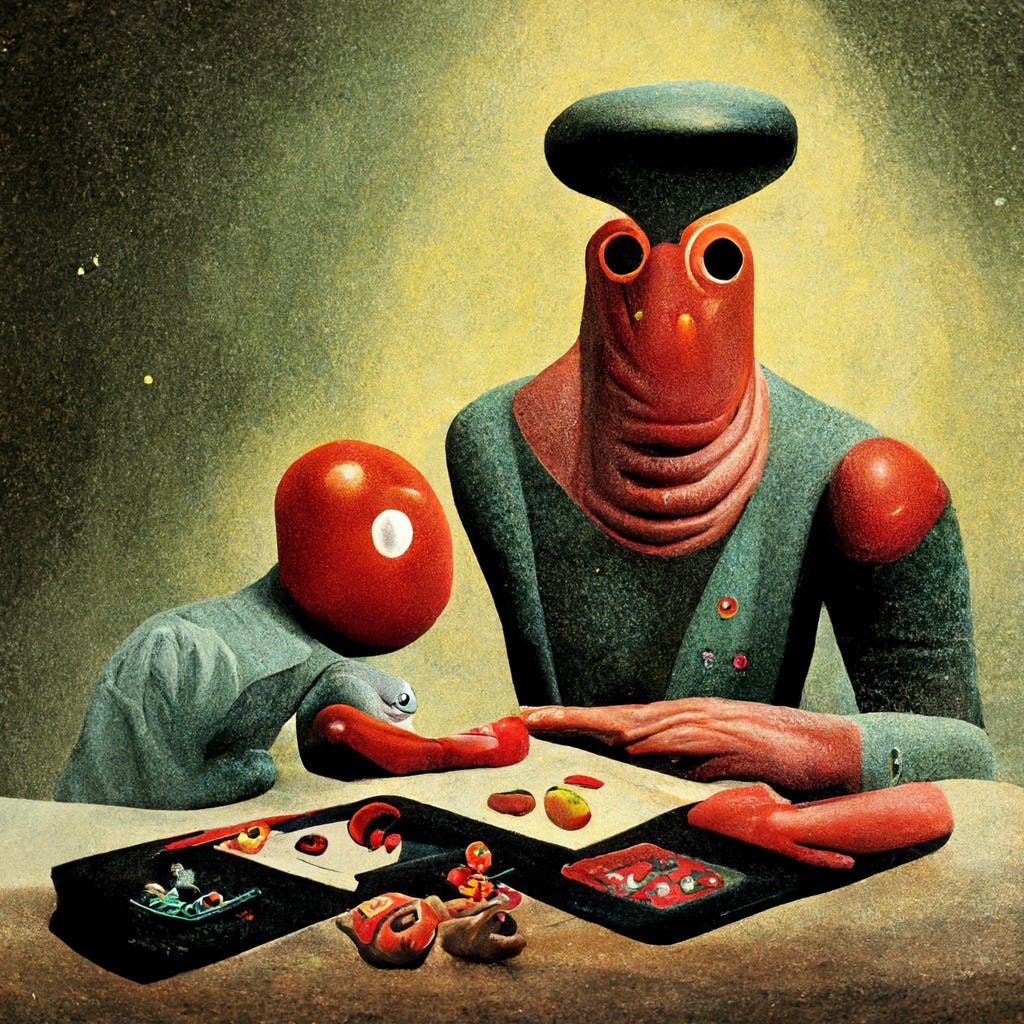
Around this time, I used Midjourney as a homework incentive/ prize for my younger students (an incentive that probably wouldn’t work now if I was still inclined to use it since kids are much more familiar with AI image creation now in 2025 than they were back in 2022). I would set some kind of creative writing task and then prompt Midjourney to create illustrations for the five or so completed stories that I considered to be the strongest, which would then be projected up on the white board.
In Jan Švankmajer’s 1994 feature-length adaptation of the Faust myth, Lekce Faust, Faust (Petr Čepek in his last role) plays the titular magus who makes a pact with the devil as a bemused and often ironically detached everyman pupeeteered by socio-political forces beyond his understanding. Švankmajer quotes from Marlowe’s, Goethe’s and Czech puppet versions of the story across his film, though for an English viewer like myself, it’ll likely be Marlowe’s play that they are most familiar with. Two characters present from Marlowe’s play are the sinister alchemists Valdes and Cornelius who tempt Faust into the persuit of heretical knowledge. Played by Jan Kraus (a previous collaborator of Švankmajer’s) and Vladimír Kudla, the pair are certainly still sinister, but they aren’t really possessed of any transcendental magic, just tricks and sleights of hand. They place white shell caps over their eyes to make themselves appear pupil-less while staring up at Faust from the street. Later they use a cockscrew to drill down into a hidden barrel of wine to make it flow up through a hole in a table.
In projecting the Midjourney-created illustrations of the students’ stories I was like Valdes and Cornelius, flattering my students’ egos through disenchanted technology masquerading as profane magic.
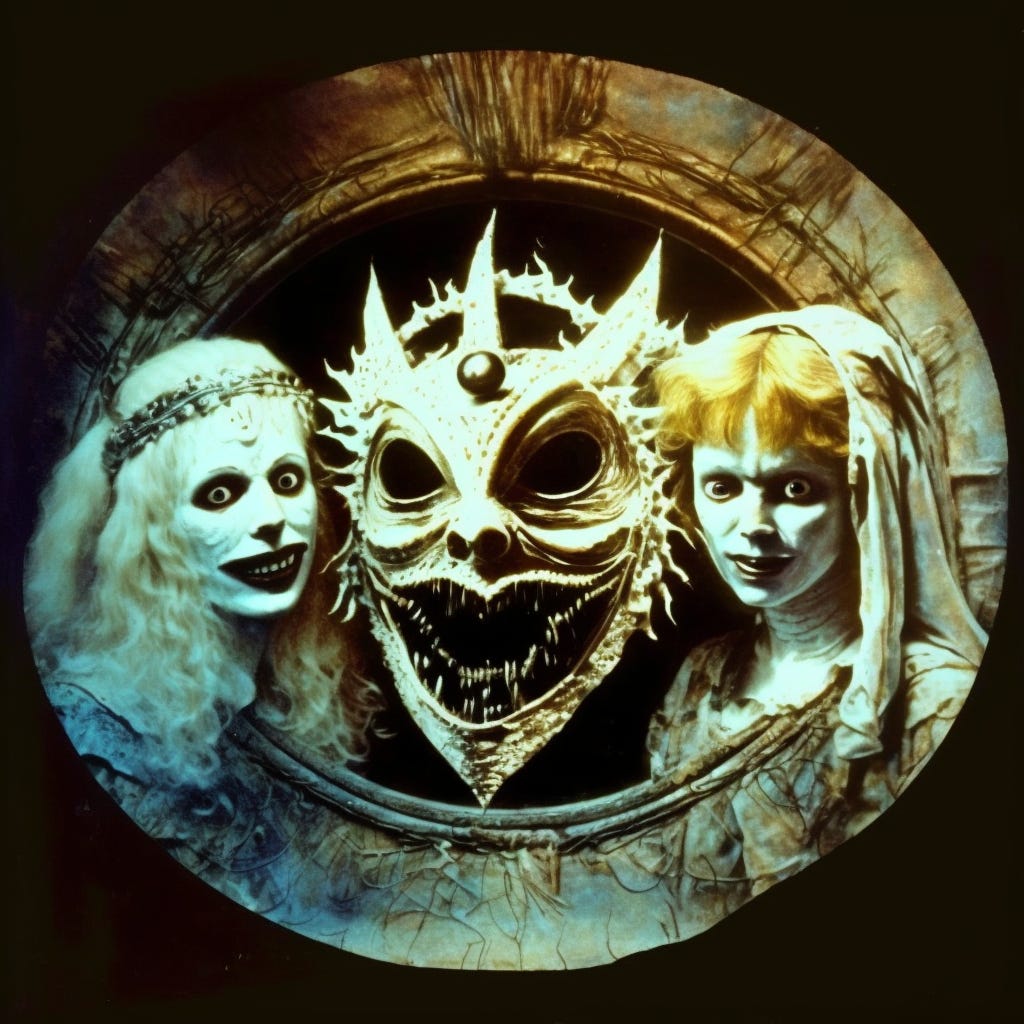
Discussing Lecke Faust in interview with Peter Hames, only a short while after the Czech Republic’s emergence from Communist Czechoslovakia into Western-style Consumer Capitalism, Švankmajer made such cynical reflections as:
Advertising replaced iconographic church art. Contemporary society brought up on the idea of consumerism needs reliable and effective advertising. This is the real ‘official’ art of the present (thus it is the best paid). If advertising were not effective and people stopped consuming completely unnecessary products, the economy would crumble and bring down with it the whole of contemporary society.
(Švankmajer in Hames, The Cinema of Jan Švankmajer: Dark Alchemy, 2nd edn, 2008, p.114)
and:
Half the world played the ‘social justice’ game while happily murdering people in its name and the other half played on the ‘freedom of the individual’ while, using advertising tricks, creating unified consumers who did not have their own will and happily licked up any old scum.
(Švankmajer in Hames, The Cinema of Jan Švankmajer: Dark Alchemy, 2nd edn, 2008, p.114)
I remember reading this as a callow 21-year-old and thinking “Oh Švankmajer, so naive – of course that’s what advertising does! Didn’t you already know that?” I had not yet fully internalised the point that David Foster Wallace made in ‘E Unibus Pluram: Television and U.S. Fiction’ (1993) that the viewer who rolls their eyes knowingly at television adverts, while continuing to watch, is just as manipulated as the truly credulous… smarmily recognising that you’re happily licking up any old scum doesn’t mean you’ve stopped licking up the scum.

Nate Bear, a writer I’m often impressed by, has explained that the teleological nature of capitalism, by which the process of production is obscured in favour of the finished commodity form, is entirely congruent with development of DALL·E, Midjourney, et al.
The emergence of Ai art is entirely logical under capitalism. Because Ai music and writing tools valorise the output over the creation. They exist not to enhance the creative process but to strip out the creative from the process. From an ideological perspective, it is an intensely capitalistic endpoint. The essence is the output. And because the output is what sells, what gets downloaded and streamed, that’s the virtue. There’s only profit, is the message. And even our brains are not sacred.
Švankmajer, in his production of collages from magazine cuttings and sculptures from bones and found objects, has long reworked and transformed others’ materials into art according to his own sensibilities.*
*Švankmajer would not agree with my framing of any of his practice as “reworking” anything into “art”, nor the mention of his “sensibilities”. He would argue that he is engaged in an alchemical process of inner/outer transformation that is part of his daily-lived and -dreamt life, which does not ultimately produce Art (with a capital ‘A’).
However, I’m confident in asserting that he would not use AI in the production of his work (not least since he is on record expressing his distaste for CGI animation). This is not because I think the Czech Surrealist is concerned about plagiarism or copyright, but because he is a stubbornly hands-on meticulous filmmaker; whereas using prompts to generate images through stable diffusion requires the user to reliquish a great deal of control to a technology they likely barely understand. While the user can refine their prompts, ultimately their role is less that of the artist than that of a curator or collector, selecting their preferred image like a tourist selecting a postcard from an – admittedly infinite – gift shop rack. Now, that rack has been sub-divided into near-infinite categories, which the tourist is going to choose between as per their aforementioned “sensibilities”, but this is not so very different from choosing from hundreds of tags on Steam to find the videogame you want… only the games didn’t exist before you chose the tags.
It is hard to find the right analogy here because using AI to create images through stable diffusion can’t be neatly mapped to previous phenomena. I’m not convinced by arguments that the generation of such images is stealing per se (even though it might //feel like it is// if the AI has been trained using your art without your content) because such images are produced probabilistically in a way that very closely resembles but fundamentally isn’t imitation. The Chinese room thought experiment cuts both ways. Say, I’d never seen Van Gogh’s ‘Haystacks’ (the one with the workers laying down against the hay). I could follow instructions on how to replicate the painting (such as provided here through Google Vignette) without ever having looked at the painting or without having been told that there was even originally such a painting. If the instuctions were minute enough then, theoretically, I could end up with an imitation without knowingly having plagiarised.
However, what Midjourney is doing is a step even further removed from plagiarism. Instead of a set of straightforward imitative instructions being given, stable diffusion creates a signal from Gaussian noise via complex probabilistic reverse engineering (ethical or not, this still impresses me as impossibly cool). Probalistically if such an image yet to exist were to be tagged with ‘bright sunny day’ then it would be likely that the upper quarter of the image would be blue; probabilistically if such an image were to be tagged with ‘impressionist’ then it would be likely that the colours would sort of swirl and merge together; probabilistically if such an image were to be tagged with ‘1880s’, ‘Provence’ and ‘male peasants’ then it would be likely that the peasnts pictured would be wearing blue smocks and fustian suits etc. etc. etc. etc. etc. Not that the AI is thinking in English language in the same way we do. Rather, it calculates upwards from latent space to pixel space what the dimensions of such an image should be (within a field of variation established by the user, which he/she can then further refine).
No, Švankmajer wouldn’t care that such an image might end up being too close to someone else’s original work – not least since he would likely then transform the image through printing it off, cutting it up, before then using the pieces to papier-mâché a mask of a chicken with – but he would be alienated by the abstraction and obfuscation of the process which, as Nate Bear says, ossifies the finished product as pure commodity. Tellingly, Švankmajer’s features since Faust have only furthered his attempts to demystify his own filmmaking. Conspirators of Pleasure (Spiklenci slasti) from 1996 – where it is porn magazines that are cut up to collage a chicken head – spends far longer on the production of the titular conspirators’ masturbation machines and props than it does upon their use of these creations. In his last dramatic feature, Insect (Hmyz, 2018), the film repeatedly cuts away to footage you would expect to see as DVD extras rather than within the feature itself, such as behind-the-scenes interviews and special effects being prepared. Process over product.
That said, Insect received middling reviews. Many people like a bit of mystification. Švankmajer’s last feature, Kunstkamera (2022), by contrast is largely a filmed exhibition of Švankmajer’s stuff, with little indication as to when the viewer is looking at a found object/readymade or a sculpture assembled by Švankmajer (or anything in-between). While more august, this is perhaps not dissimilar to me exhibiting my old AI generated images in this blog entry. The images I like, whatever their providence, tells you something about me; gives you an indication of my way of seeing the world, even if the view has not been fully composed by myself so much as scavenged.
Two weeks ago I walked the Ipswich art trail and visited The Turning of the Tide, a contemporary art exhibition at St Clement’s Church. Most of the art was pleasant enough, though a little underwhelming; however, there was one piece that on a basic, reactive, gut level (and I write that as a frikkin’ namby-pamby Unitarian) I found blasphemous, which was Medeology Collective’s ‘D-A.I-ity: Techno-Theological Triptych’. This was an interesting experience for me as I very rarely find anything blasphemous.
As a teenager I remember finding some of the music of The Tiger Lillies thrillingly blasphemous, especially their enthusiastically NSFW track ‘Banging in the Nails’ from the point of view of a Roman who helped to crucify, degrade and torture Jesus as he died (and would clearly cheerfully do so all over again). I remember, with teenager edgelord inverted-sanctimoniousness, playing it to shock my pre-teen brother… and then feeling deeply guilty and sad when it did upset and shock him, compelling him to recite the lyrics to our younger sister to upset and shock her, which it did.
‘D-A.I-ity: Techno-Theological Triptych’ largely consists of paintings by Hieronymus Bosch seemingly infinitely refracted and reflected into the distance, before which AI-generated faces imitate YouTube reaction head shots of exaggerated open-mouthed shock and awe, with some pop culture detritus and vaguely scatological imagery thrown into the mix. However, I don’t think it was the irreverence with which the creator/s were treating religious and sacred iconography that unsettled me…
I think back to the other couple of works that I remember eliciting a similar response from me and intriguingly – and presumably not coincidentally – they also played fast and loose with other people’s artistic output to the point of plagiarism (while carefully skirting copywrite laws). One is Kathy Acker’s weird visionary cut-up novel Don Quixote: Which Was a Dream (1986). I remember the material nicked from de Sade’s Justine (1791) especially hit me with the force of religious wrongness, but I don’t think it was simply due to de Sade’s own perverse inversion of Christian morality [ultimately bothering dedicating oneself to such inversions implies that the writer is, on some level, invested in the moral system they are parodying or critiquing – just as de Sade’s work can hit with a weird moral force if you’re in the right head space, The Tiger Lillies’ music often strikes me as being bittersweet as much as it is carnivalesque]. I couldn’t get through Sodom (1785) because I found the experience of reading it too unpleasant and disturbing, but Acker’s trickery troubled me on a deeper level because I didn’t know where her authorship ended and de Sade’s begun. I felt like I knew where I was with de Sade – an intelligent pervert and misogynistic sadist – and that I could situate my own morality in relation to his own (i.e. in opposition to it). By contrast, I couldn’t even tell what words belonged to Acker, as though there was just a howling void behind the written page.
The other work is Švankmajer’s Lunacy (Šílení, 2005), which is – in part – an adaptation of de Sade’s life and works. As such, it includes an orgiastic black mass and the desecretion of religious iconography, as well as the ethnically dubious casting of developmentally-disabled performers as inmates-cum-patients of the Marquis’s asylum.*
*It should be stated that a behind-the-scenes featurette suggests that the performers all had a good time, which is more than can be said for performers in older arthouse exploitation movies who were potentially not able to fully understand the situation they were performing within, such as the Ya̧nomamö and Shamatari teenagers sexually assaulted for Cannibal Holocaust (1980) [the filmmakers did not bring along translators]. Švankmajer does have a tendency to treat and film his performers as puppets, but I don’t believe he would permit his set to descend into the kind of destructive chaos that seemingly characterised the ‘set’ of Deodato’s film, nor would he abuse his position to allow him to enact his sadistic fantasies upon a performer, as per Jodorowsky upon Mara Lorenzio in El Topo (1970) or, to a less disturbing degree, Hitchwork with Tippi Hedren in The Birds (1963).
However, what possibly unsettled me more was the unsignposted intermingling of de Sade’s works with two stories by Edgar Allan Poe: ‘The System of Doctor Tarr and Professor Fether’ (1845) and ‘The Premature Burial’ (1844). I am a massive fan of Poe’s writing and like to consider the author more of a neurotic romantic than an outright sadist. However, the fact that I found it hard to tell where Poe left off and de Sade began (and vice versa) implied that there was more of the latter in the former than I liked to admit.

I’m actually such a fan of Poe that I adapted all but three of his short stories (in addition to several poems and essays) into a wildly branching choose-your-own-adventure hypertext pastiche. Generally reviews from the Interactive Fiction Comp of that year were favourable, but one more negative review by Jenni Polodna argued that my own sections of pastiche weren’t critically distanced enough from Poe’s Victorian patriarchal standpoint… What I had intended as (affectionate) criticism or deconstruction, just ended up looking like imitation. Polodna especially took issue with a part of the game in which I reworked Poe’s rather naff shaggy dog story ‘The Spectacles’ (1844), in which the narrator is horrified to discover that, without his spectacles, he has fallen in love with his elderly maiden aunt. Polodna narrated her experience in playing:
Anyway I’m in the theatre and there is a lady and she is ver bootifoo and I am in love with her. This is what is happening in this game currently.
…the only option I am given is to gaze at her for half an hour, so I guess that’s what we’re doing!
Now she is staring back at me! She loves me too!
…then the twist ending is that up close she turns out to be eighty-two years old and therefore, definitionally, neither beautiful nor deserving of love.
And you die in a pique of manly shame.
You are dead.
As a woman who just turned, what the shit am I, thirty-six? thirty-six, already feeling the effects of my inevitable slide into the irrelevance and sexual repulsion that accompanies aging in females, I gotta say that ending made my ass twitch just a little bit.
Now, to me, having the narrator die in a “pique of manly shame” made it clear that I found the narrator of the story ridiculous and eminently worthy of mockery, making him the butt of the joke and not the elderly woman. My authorial distance from Poe (at least in ideological terms!) was seemingly less clear than I had intended.
So, why did ‘D-A.I-ity: Techno-Theological Triptych’ trouble me so? I think it was partially seeing what seemed to me a rather flippant and irreverent work of art in a space which, hundreds of years ago, had been built and occupied by sincere believers; but more to the point, it was the lack of a clear artist owning that sincerity or lack of sincerity. Where did the orthodox Christianity of Bosch end and the post-modern nihilism of the Medeology Collective begin and why on earth would this matter to me? I spout off regularly about the benefits of ambiguity and ambivalence in unsettling horror, but suddenly I was interested in respecting the traditions of a patriarchal Church that has often been used as a system of repression and control! Would I be defending copyright laws and trials for public displays of blasphemy next???
Two days ago I returned, with my partner, to St Clement’s Church to see a new exhibition of photography by the Ipswich and District Photographic Society. While I thought photos by one of the junior members displayed an impressive eye for composition, some of the photos (several of which were displayed in surprisingly low resolution) were less visually interesting, well-composed or simply aesthetically pleasing than what Midjourney would produce if I fed it the prompt of ‘Photo of Ipswich in Suffolk’. Now, arguably, adjusting a camera’s focus, steadying one’s hands etc. might take marginally longer than typing in a prompt, but just as AI (and, behind it, the labour of programmers and prior artists) produces the image the user takes credit for, nature and other humans have already done much of the work for the photographer. Indeed, if much of the craft of the photographer is sorting through a whole wadge of photos to choose the one which is more interesting, well-composed and aesthetically pleasing (or best communicates an idea or a feeling they have) then little distinguishes the photographer from the adept user of Midjourney or DALL·E, especially if the user is then employing Photoshop to further refine and alter their images or combining these images into a meaningful sequence or exhibition.
Notably, however, the photograph my partner and I discussed most after the exhibition was not one that could be easily praised according to its composition or aesthetic features. Instead, it was a straight-on, not especially well framed mid-shot of a Co-Op supermarket in Ipswich. All three photos taken by the photographer were similarly banal, but what caught our interest about this particular shot was that it had been entered under the competition category of ‘Inspiration’, with a short blurb explaining how he, the artist, had moved to a house near this Co-Op and so was ‘inspired’ to regularly visit it. I felt there was something profoundly Zen in being inspired by such a humdrum building. We debated whether the submission was a knowingly ironic joke, or was genuinely meant in earnest (I choose to believe the latter). Curiously, my pleasure from the photograph took much the same form as my displeasure in thinking about the AI art exhibit from the two weeks previous. I was caught up in the same questions about authorial intent and sincerity vs. irony, except in this case I felt confident that there was a unified human mind (with thoughts and emotions) behind the art, which was (presumably) meaningful to him.
Under this logic I should value my most disappointing aesthetic experience ever – my experience of playing Simon the Sorcerer 3D (2002) – over the delight I feel when looking at AI-generated grotesque parody screenshots of that game.
Here is a screenshot from the real Simon 3D:
And a fake screenshot:
The first image makes me feel angry while the second image makes me laugh. I can’t help it! Those lazy-assed brick textures compared to the textures in the first two Simon the Sorcerer games! By contrast, the shrugging expression that the gnome is making in the second image! The bland, uninspired colours in the actual game compared to the riotous patchwork of reds, yellows and oranges of the rug in the fake screenshot! The complete lack of whimsical charm in an image containing a fairy godmother next to the sublime impossibility of a gnome simultaneously standing inside and outside of a TV screen all at once!
Okay, so beauty is in the eye of the beholder, but my point is that we bring our own meaning/s to images even when we might logically reason that a given image is void of such meaning/s. The first image will always represent to me Adventure Soft tanking their own franchise (after the terrible insistence from their publishers that the game be rebuild in 3D) while the second image represents my attempt to claw some pleasure from what was (illogically or otherwise) one of the biggest disappointments of my childhood.

Two hours ago I continued writing this article in Google Chrome because I can’t remember my Substack password and it’s logged in here not Firefox. I searched for much of the information for this article using Ecosia, but occasionally I couldn’t find what I wanted and so used Google. This laptop is running on Windows largely because I can’t currently afford a Steam Deck to play the hundreds of Humble Bundle games I’ve purchased (with proceeds going to charity!) over the years, with the plan being to switch this laptop to Linex. Hopefully if you are reading this, you do better than me on this score, though I might do better on the not taking flights or eating meat front, etc. The point is, it is exceptionally easy to do deals with the devil on a daily basis in this society and face little-to-no pushback. Like driving a car when one could walk or cycle, these little evil acts are largely crimes of convenience. It is convenient to use AI to generate images because it does not require you to put the hundreds or thousands of hours of work into getting better at drawing or painting pictures. It is convenient to not to have to pay an artist for commissioned work. As hinted above, I’m not completely swayed by the argument that AI art is plagiarism or theft in any traditional sense (no more than I’d say amateur artists who developed their style by tracing manga artists’ work plagiarised those artists in learning how to draw) though it clearly puts many artists out of business. However, the carbon footprint and water usage of generative AI models does bother me – enough that I no longer use Midjourney. We all pick which devils we’re willing to dance with.
Still, in the years to come, I’m going to find it hard to resist the temptation to create a chatbot in the form of W.N.P. Barbellion to chat about nature and classical music with, to generate a live-action film version of the visual novel series Umineko, or produce more albums in the style of Picky Picnic. These would seem like acts of adoration but really they’d be acts of disrespect and discretion. That said, I strongly suspect that ten years front now holding such a view will seem weirdly puritanical, even ascetic. Most of us will be watching and listening to AI generated content specifically algorithmically tailored to our own tastes, with no need for us to stretch ourselves by engaging in opposing ideas or viewpoints (unless ‘contrarian’ is one of the tags we select) or even empathetic leaps across communicative and cultural divides. Tennessee Williams once wrote “Personal lyricism is the outcry of prisoner to prisoner from the cell in solitary where each is confined for the duration of his life”. In the future, we will have our personal lyricism tailor-made, but will not cry it out “prisoner to prisoner”, but enjoy it in the solitary confinement of our own cells.
The following are other Substack articles from over the last year on AI that I have really enjoyed; however, I am going to follow them with links to bands/ artists I like that have used AI in ways I find interesting as a counterpoint. Unless you’re an accelerationist (which I am not) I don’t think there are compelling logical arguments for the moral or aesthetic superiority of AI art over non-AI art. However, part of my argument here has been that the way we respond to art is often emotional and reactive rather than logical. Like the Medeology Collective’s work, the music videos that follow these critical and condemnatory articles have provoked a strong emotional reaction from me.
Articles:
Music Videos:
‘Cold War Bop’ by The Indelicates
Simon Indelicate is going to disagree with much of this article (but, then again, he is something of an accelerationist). The uncanny nostalgia he conjures with this video would be less effective using straight archival footage. Plus, I think putting Julia’s face into so many iconic scenes of the past shows his love for his wife in an odd, disarming way.
‘It’s The Truth’ by Kirin J Callinan
Sometimes Callinan doesn’t quite manage to push past post-modernism into something that feels substantially new; other times I think he reaches an esctatic fever pitch of kitsch like David Lynch at his best. I’m not sure what this one is doing, but I like it a lot!
‘White Guys with Guns’, The Residents
The whole of the Dr Dark album uses AI art, both for the album cover, but also for art inside the album booklet, representing paintings created by Dr Anastasia Dark, the Jack Kevorkian-like character around who much of the album is centered. The art is suitably janky for The Residents and for a band that has always worked at the intersection between avant-garde artistry and P.T. Barnum-style hucksterism, it would be weird if they didn’t use AI. The album is a compelling one, with glimpses of beauty amongst the ugliness, though as with The Voice of Midnight (2007) I struggle with some of the guest vocals.
‘Yume Nikki Dark Fantasy’, Me
Not a music video, but my attempt a couple of years back to produce something that simply would/ could(?) not exist without AI image generation. I was really enjoying the fake film stills of ‘dark fantasy’ film adaptations of video games, so I used Midjourney to generate a whole bunch based upon locations and characters from the famous free game Yume Nikki. The editing and voice-over narration required some imagination and basic skill on my part so I felt as though I was integrating AI imagery into something legitimately creative. I may have been wrong.


